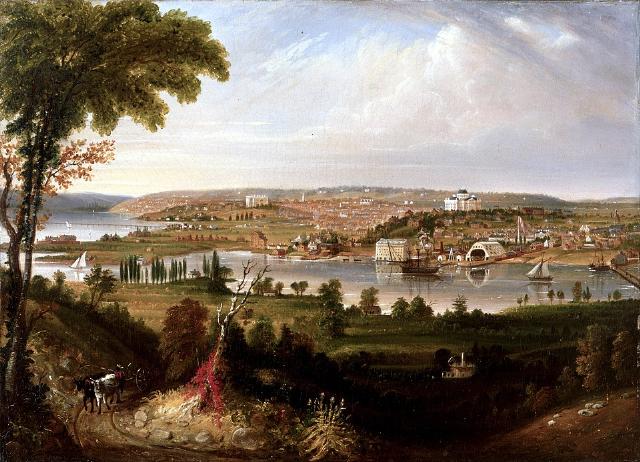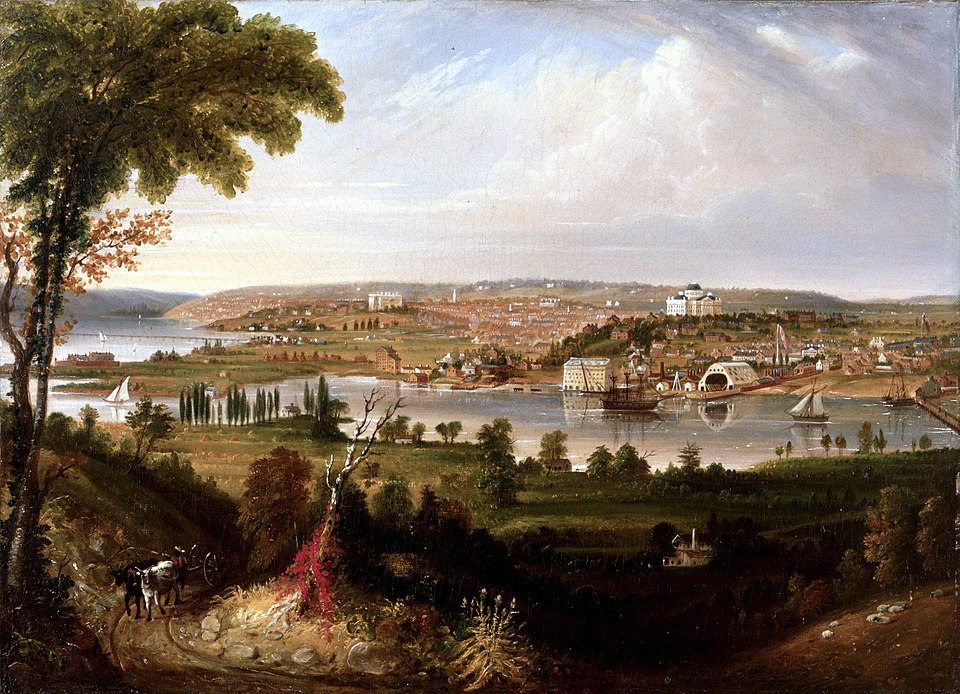

Photo Credit:George Cooke, Public domain, via Wikimedia Commons
WC
Architecture is a choice of ideology. How we design public space is a suitable material for an anthropological study, and it says everything about who we are, our perspectives on life, death, and eternity.<img alt="George Cooke, Public domain, via Wikimedia Commons" captext="WC” src=”https://conservativenewsbriefing.com/wp-content/uploads/2025/04/rebirth-of-beauty-and-faith.jpg”>
Image: City of Washington from Beyond the Navy Yard (George Cooke, 1833)
In the Middle Ages, like rats in a burned-down barn, wayfarers sought refuge in the oversized ruins of the Roman Empire. In such places as the Forum and the Palatine Hill, shepherds roamed with their flocks. Although preoccupied with simple survival in an anarchic world, they might occasionally have glanced at the derelict, overgrown marble temples and wondered what gods once walked the earth and created such magnificent beauty. In terms of pure sensory experience, of course, they were never worse off than scholars with historical or philosophical knowledge. The classical ideals of architectural beauty, based on organic motifs, symmetry, and balanced proportions, have — like the anatomical (and natural) beauty of the human body itself — always been for everybody to recognize and appreciate.
Eventually, Westerners broke out of the darkness and rediscovered the Greco-Roman world. As it is usually phrased, the aesthetic ideals of antiquity were “reborn” in fourteenth-century Italy. The change was particularly noticeable in the plastic arts and architecture.
Andrea Palladio (1508–80) is celebrated as one of the greatest architects of the Renaissance. With his strict, tradition-conscious demands for monumental construction and proper use of decorative elements, but also very much an innovator with a rare sense of architectural grandeur and harmony, it is difficult to overstate his importance for the architectural idiom in the West. Himself inspired by Vitruvius (ca. 80/70–15 B.C.), his practical influence lasted for several centuries. It was not until the breakthrough of modernism after WWI that he was finally relegated to the history books. His hugely influential treatise, “The Four Books of Architecture”, has long been excluded as a mandatory part of the curriculum at Western schools of architecture.
Deeply fascinated by classical culture, Venetian humanist Gian Giorgio Trissino, his patron and personal friend, first showed Palladio around Rome on a study tour in 1541. In addition to several return visits to Rome, in the following years he conducted field studies at Hadrian’s villa in Tivoli. Trissino had originally hired him to build his villa but ended up becoming his mentor in the exploration of Roman architecture and mythology.
Some buildings have been lost, but for those who truly honor the idea — and the historical past — of the West and dare to embrace a spontaneously captivating beauty that encapsulates everything that we used to be and believe in, there are numerous villas (e.g. Villa Rotonda), palaces, and churches to visit in Veneto.
Fortunately, beauty, true to its original essence, despite the widespread “fetishism of ugliness”, continues to exist and inspire, whether it finds immediate expression in opera and ballet or is immortalized in oil painting and sculpture.
Perhaps it is not way off the mark to claim that, after the end of WWI, we have gone back to the Middle Ages, groping in the dark. Having departed with the aesthetic ideals of antiquity and Judeo-Christian religiosity, it is increasingly clear that we find ourselves in a crippling “identity crisis”.
This crisis is not a universal phenomenon, though. The ideas that govern individuals are shaped largely by the culture to which they belong and are therefore not the same from one part of the world to another. Neither Muslims in the Middle East and Africa nor atheists in communist countries of the Far East, by the looks of it, suffer from Western-style self-destructive guilt complexes.
A power vacuum in human society, be it a remote village or the world community itself, is never allowed to last long. If the prevailing view in the West is that we have nothing worth fighting for, we will face our known enemies at a fatal disadvantage. We may look down on non-Western cultures as both technically and socially backward. However, if aliens have faith in themselves and the will to fight, convinced believers with an expectation of ultimate triumph, they could soon surprise us on the battlefield of Western society. As it stands, the demographic balance between Christians and Muslims has been tipping in recent years. Insidiously, ancient cities are changing hands. If we have already decided to lay down our weapons and let the barbarians occupy our homes, the death throes of civilization will be short-lived.
A lasting relationship at the heart of the identity crisis is obvious:
Architectural classicism symbolizes Western civilization.
Therefore, it is inalienable. It exudes an unwavering confidence in beauty, freedom of thought, and the rule of law. Those, who attack the tradition after Palladio, are typically engaged in forging plots and destroying love for the distinctive culture on which our societies are built. If not supporters of “socialist internationalism”, prominent enemies of the tradition (e.g. Le Corbusier) were originally eccentrics with autistic dispositions and complete alienation from human compassion and devotion.
The Greco-Roman idiom, in essence, is the face of civilization. This very idea caught on in America, having to build its cities from scratch. With a layout for Washington D.C. by Pierre Charles L’Enfant, dominant styles in the cityscape were formerly Georgian, Palladian, etc.
The smart-sounding term “international style” in architecture is actually a bit of a misnomer. In reality, it refers to the absence of any style. More serious than that, if understood in its proper historical context, it denies the ties to Western aesthetic tradition and civilization. It signals an implacable attack on the West as defined by Greco-Roman ideals of beauty in conjunction with Judeo-Christian religiosity.
The “international style” is a child of modernism, thus equally a “child from hell”. It expresses inwardly a “nihilistic” urge to destroy everything that might remind us of who we really are, and at the same time outwardly a “masochistic” urge for surrender. In short, modernism and its evil child represent an inexcusable betrayal of the West. Strictly speaking, modernists are to be regarded as traitors to our inherited concepts of aesthetics and ethics.
For most people, it means something to have a sense of belonging somewhere in the world. As our cities, proudly and painstakingly built by our ancestors, testimonies to a historical legacy, the outward expression of our civilization, are desecrated, the feeling of alienation grows.
With the loss of “home”, loyalty to everything that our ancestors held dear gradually fades. In a somewhat sick sense, everybody is forcibly transformed into “internationalists” — or more precisely: we become homeless and therefore without a home to love and defend. It follows from “multiculturalism” in our latitudes that nobody has the right to feel more at home than anybody else who happens to be passing by and decides to settle down. Thus, modernism has also been an open invitation to self-deprecating relativism in the West.
Even in an era when life on earth can be wiped out in a few hours by capricious tyrants, we must ask ourselves this question: “Do we intend, like the blasphemers of the Middle Ages, to surrender to sensual pleasures, without faith in tomorrow, or are we prepared to stand against the urges of folly and fight for everything that is beautiful and good in the world as we know it?”
Indisputably, refining the cultural trends of his time, Palladio was instrumental in rescuing us from the chaotic, life-denying, and flagellantic darkness of the Middle Ages and giving us back the joy of life from antiquity. Threatened by barbarians invading our lands from outside, but even more so by false apostles tempting us to renounce and remove every trace of our own past, we are back in the Middle Ages.
What the shepherds in the ruins of Rome realized as they drove their animals back and forth between the hilly pastures: Beauty is simple. Like piety. To long for your beloved as she smiles and reaches out for you, or to pray to your god, requires neither pedantic reminders from others nor metaphysical studies.
Those, who steal beauty from us to give us ugliness or nothingness in its place, are the same ones who try to steal our faith from us. And our hope.
It is doubtful, at best, whether we can count on another deliverance from darkness and a rebirth of beauty and faith. However, those, who both love and believe, are obliged to persevere.






